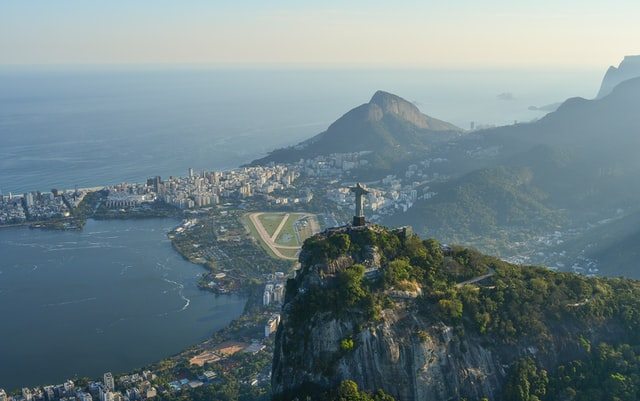Cristo Redentor
Parque Nacional da Tijuca - Alto da Boa Vista, Rio De JaneiroCristo Redentor- the most important information
Cristo Redentor is an Art Deco statue of Jesus Christ in Rio de Janeiro, Brazil, created by French sculptor Paul Landowski and built by Brazilian engineer Heitor da Silva Costa, in collaboration with the French engineer Albert Caquot. Romanian sculptor Gheorghe Leonida fashioned the face. Constructed between 1922 and 1931, the statue is 30 meters high, excluding its 8-meter pedestal. The arms stretch 28 meters wide. It is made of reinforced concrete and soapstone. A symbol of Christianity around the world, the statue has also become a cultural icon of both Rio de Janeiro and Brazil and was voted one of the New Seven Wonders of the World.
History of the Cristo Redentor
Vincentian priest Pedro Maria Boss first suggested placing a Christian monument on Mount Corcovado in the mid-1850s to honor Princess Isabel, regent of Brazil and the daughter of Emperor Pedro II, but the project was not approved. In 1889 the country became a republic, and owing to the separation of church and state the proposed statue was dismissed. The designs considered for the "Statue of the Christ" included a representation of the Christian cross, a statue of Jesus with a globe in his hands, and a pedestal symbolizing the world. The statue of Christ the Redeemer with open arms, a symbol of peace, was chosen. Construction took nine years, from 1922 to 1931, and cost the equivalent to $3,600,000 in 2020 and the monument opened on October 12, 1931. More work on the statue and its environs was conducted in 2003 and early 2010. In 2003, a set of escalators, walkways, and elevators were installed to facilitate access to the platform surrounding the statue. The four-month restoration in 2010 focused on the statue itself. Maintenance work needs to be conducted periodically because of the strong winds and erosion to which the statue is exposed, as well as lightning strikes.
Opening hours and tickets for Cristo Redentor
- Opening hours: You can visit this statue every day from 8 am to 7 pm. Depending on the holidays, working hours can be changed.
- Tickets: You can get to the statue for free, except that you have to pay for transport. There are several tours that provide you with some sightseeing and tour guides, and their prices start at 20 USD.
How to get to Cristo Redentor?
- via COG TRAIN: The most famous and traditional way how to reach Christ the Redeemer is by cog train. The train will take you through Atlantic Forest almost to the top of Corcovado Mountain. The train leaves approximately every 30 minutes, and the ride up takes 20 minutes. To avoid queues, buy your Christ the Redeemer Cog Train Ticket online on the official website of COG Train in advance for the exact time, so you won't have to wait long.
- via Van: Another option how to get to Christ the Redeemer is by taking a van. This option is slightly cheaper than going to Corcovado Mountain by cog train but is not that comfortable and in our opinion lacks the sense of adventure. You can either take a direct van from Copacana or Barra da Tijuca as we mentioned above, or you can arrive at Trem do Corcovado by public transport and from here take a taxi. This costs around 7 USD.
Cristo Redentor trivia:
- In October 2006, on the 75th anniversary of the statue's completion, Cardinal Eusebio Oscar Scheid, Archbishop of Rio, consecrated a chapel, named after Brazil's patron saint—Our Lady of the Apparition—under the statue, allowing Catholics to hold baptisms and weddings there.
- Lightning struck the statue during a violent thunderstorm on February 10, 2008, causing some damage to the fingers, head, and eyebrows. The Rio de Janeiro state government initiated a restoration effort to replace some of the outer soapstone layers and repair the lightning rods on the statue. Lightning damaged it again on January 17, 2014, dislodging a finger on the right hand.
- In 2010, a massive restoration of the statue began. Work included cleaning, replacing the mortar and soapstone on the exterior, restoring iron in the internal structure, and waterproofing the monument. Vandals attacked the statue during renovation, spraying paint along the arm. Mayor Eduardo Paes called the act "a crime against the nation". The culprits later apologized and presented themselves to the police.
- In reference to Brazil striker Ronaldo's usual goal celebration of both arms outstretched, the Pirelli tire company ran a 1998 commercial in which he replaced the statue while in an Inter Milan strip. The commercial was controversial with the Catholic Church.
- During the unveiling of the restored statue, it was illuminated with green-and-yellow lighting in support of the Brazil national football team playing in the 2010 FIFA World Cup.
Amenities
Type of Attractions
- Brige
- Museum
Location
Request Booking



